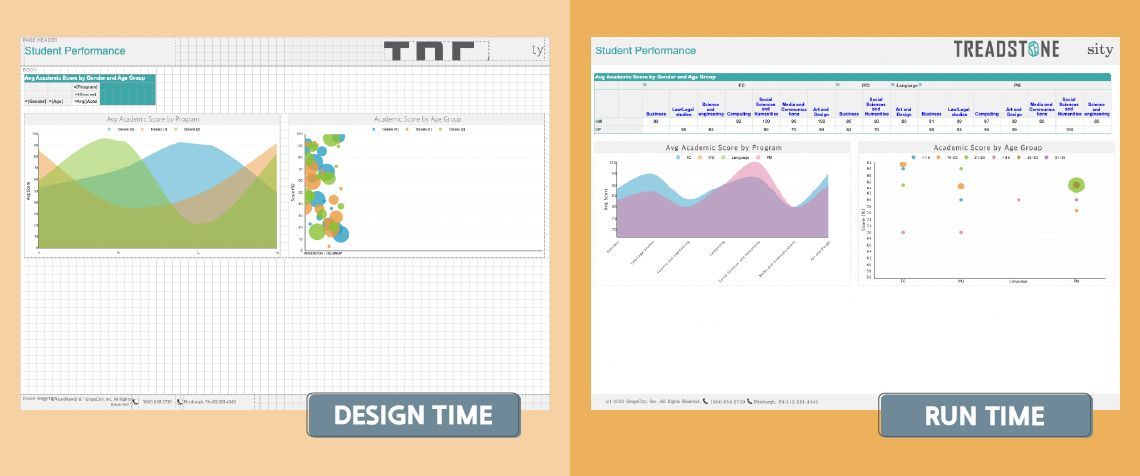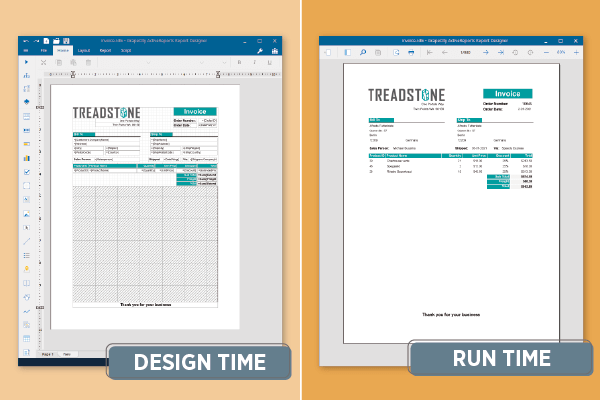ActiveReports.NET Report Types
ActiveReports.NET provides a variety of ways to design .NET reports.
You can choose from several report options in a variety of file formats to create the .NET reports you need.
RDL Report
An RDL (Report Definition Language) report is a report format that allows you to freely create report control layouts without layout restrictions such as control size and page size.
In RDL reports, controls can expand and contract based on the available data size. Similar to page reports, data areas, such as list and table controls, can be used to group data to display repeating sections. These controls expand based on the size of the dataset, so the rendered results vary depending on the number of records in the data.
RDL reports are ideal for long, tabular reports like standard ledgers and invoices, or for flexible reports with variable-sized data, or for arranging tables and charts using various data sources, rather than fixed-layout forms. When the control expands to accommodate the data, ActiveReports.NET divides the report into pages based on the report's page size setting.
RDL reports also provide the ability to create and use master reports. Master reports allow you to maintain consistency across reports, including common features like data, company logos, and page headers and footers. The body of a master report can be used to add content reports, and the master report serves as a "template" shell that other reports inherit. This allows users to quickly change company addresses, themes, and logos across an entire set of reports from a single, convenient location.
RDL reports offer a simple design experience with ActiveReports' WYSIWYG designer. Take full advantage of interactive features like parameters, sorting, drilldown, drillthrough, tables of contents, and bookmarks to create even more complete reports!


Ask anything!
Please share your vague concerns and questions about ActiveReports.NET with MESCIUS's expert team. We empathize with your concerns and are here to help.
Page Report

Page reports offer developers a new way to create reports with a focus on layout. These specific report styles are difficult to achieve in other .NET reporting tools.
Design a page-level report in Page Layout. Each page acts as a container and can be presented as a copy of the first or a new page. This allows you to design different layouts for each page and place controls anywhere on the page.
The size and position of these controls are precisely defined when designing the report. At runtime, the controls do not reposition or resize based on available data. Any overflow of data is
You can connect it to an OverFlowPlaceHolder control. Data areas, such as list controls and table controls, can be grouped to display repeating sections.
Page reports are extremely useful for creating invoices, billing statements, mail merges, catalogs, regulatory forms, and other layout-critical reports. Because they're designed for specific page sizes, you don't need to use code or add measurements to ensure everything fits in the page report.
Unlike RDL reports, data regions remain fixed at runtime, so you can place a table on the design surface, set properties to size it exactly how you want, and it will render pixel-perfect output every time, regardless of the size of the data.
Page reports offer an intuitive design experience with ActiveReports' WYSIWYG designer. Take full advantage of interactive features like parameters, filters, sorting, drilldown, drillthrough, tables of contents, and bookmarks.
Section Report

A section report is a common ActiveReports band report type, featuring a detail section that repeats data. It also includes optional header and footer sections for groups, pages, and the entire report.
Section reports are similar to Access and Crystal reports. Using code-behind or scripts, you can respond to various events that occur during the report generation process, creating highly customized reports.
Section reports can be entirely code-based (C# or VB.NET) or XML-based, as created using the ActiveReports Designer component. The code-based and event-driven nature of section reports makes them ideal for use when extreme flexibility and control are required.
Section reports are useful for forms that output large amounts of data in a list or display data repeatedly.





